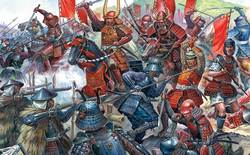Teaching and Learning Complex Subjects

New Web Programming Technologies and Drip Design
I’m currently learning web programming technologies that are new to me. The subject matter is quite complex, and I understand it on the conceptual level. But in practice, even when walked through how to apply the techniques and languages, and technologies, I don’t really “get it” yet. I find myself following along with the instructor to a certain extent, then downloading their finished code, and plugging that in, instead of following along completely, and keeping up. I am highly motivated to “get it”, but the complexity of it all makes it daunting, and I wonder if it truly is prudent to spend the amount of time I would need to spend to learn it well enough to fly on my own and create apps with it. I wonder how many times I would need to go through the classes to learn it solidly and really get it in my bones.
My motivation for learning this new technology is to keep abreast of current programming practices, and to be able to “up my game”, and create web applications more easily and quickly. I have ideas for so many tools for water efficiency and water management. I also know that the apps I’ve created to date could use updating to a slicker, less cumbersome user interface. The newest technologies employ instant updating of information without clicking extra buttons or page refreshes, so they are attractive and compelling to me. The user experience is important in attracting and retaining users of my apps.
I’m seeing a direct parallel here between my learning these programming technologies, and my teaching drip irrigation. Drip is very complex. When I teach it, I see how I talk people through it. I make it as understandable as possible, but unless someone is very highly motivated, it would be hard for them to follow through with implementing in the way I’ve taught them.
I’ve given six drip workshops in the past four years. In total, over 4oo people attended these workshops. All of the workshops had an outdoor hands-on component. I can’t help but wonder how much of the classroom conceptual instructions stuck, compared to the outdoor demonstrations.
Wordpress and Drip Design
I can draw another parallel between website creation and drip design - two very complex undertakings. In the past, before the appearance of graphical interfaces for creating websites came along, website creation and maintenance were solely in the hands of web developers and programmers. It was frustrating to the layperson who, whenever they needed even the slightest revision done to their website, they had to pay someone to do it. Now, with the inception and popularity of pre-made websites, WYSIWYG (what you see is what you get) interfaces, and content management systems (like Wordpress, Joomla, and Squarespace), anybody can have a complex website up and running pretty quickly and painlessly. Then, once it’s created changes can be made quickly and easily.
So this is an example of an extremely complex operation being simplified and put into the hands of the general public. The fact that nearly 80% of the web is populated by websites that are Wordpress or something similar tells me that anytime you can take a complex operation and create a tool or product to make that operation available to unskilled people, you are providing a huge benefit that improves the quality of life and/or business of users of your product.

Drip Design
Irrigation design is extremely complex. It’s not just about gluing PVC pipes together, or running drip tubing, plunking in some sprinklers, emitters, bubblers, or microsprays, and you’re done. There are laws of physics and hydraulics that have to be considered and applied. There is the calculation of pipe size, valve size, water meter size and flow capacity, pressure gain and loss, pressure regulation and compensation. There are soil texture, infiltration rate, water-holding capacity, and water evaporation rate from the soil to consider. These are just a sampling of the considerations in irrigation design. There are also hundreds of possible components of the irrigation system that would need to be specified for any given situation. There is optimization for the greatest water efficiency that can be achieved… really a plethora of informed choices to be made throughout the whole irrigation design process.
Irrigation design is a specialized field. Whether you’re talking about landscape, golf, or agricultural irrigation, it takes a good deal of dedicated and focused education to be able to design irrigation correctly. I am a landscape irrigation designer, so I can only speak to that field. After about three years of focused study, and acquiring five irrigation-related certifications, I felt ready to confidently call myself an irrigation designer.
While I was studying irrigation and getting certified, I was a practicing C-27 Landscape Contractor and Certified Arborist, and was running my own landscape maintenance company with six employees. During this time, I was also installing, repairing, maintaining, assessing, and upgrading irrigation systems. The last irrigation certification I acquired was my CID, or Certified Irrigation Designer certification. I considered this the prize of my landscaping career - the jewel in the crown. This was by far the most difficult certification to achieve. It involved four steps, almost $1,000 of investment, and 10 hours of exams to achieve this certification.
There are very few certified irrigation designers and consultants in the landscape trade in California where I live and practice. I believe this is because formal irrigation designs have not historically been required in this state for residential properties. But now, in 2018, as we are coming out of a serious 4-year drought, and the statewide landscape ordinance (MWELO) now requires formal irrigation designs and water calculations for new properties, there is more of a call for Certified Irrigation Designers. But still, unless a residential project is high end, the clients are not interested in paying for an irrigation designed formally by an Irrigation Designer.
But I do regularly get called on to troubleshoot existing landscapes whose plants are unhappy and culturally stressed to the point of getting diseases, pest infestations, and/or dying. These are usually landscapes that were fairly recently designed and installed, and whose irrigation was not designed nor implemented correctly.

It’s so frustrating to have to come along after the fact like this. By this time, everybody is so stressed out, it’s difficult to find harmonious and effective solutions.The designer of the landscape and the installing contractor are stressed because plants are dying, and each one wants to make the other culpable and responsible for fixing it. There is often a confusing and contentious atmosphere around figuring out what went wrong, and who is responsible. These situations are plentiful and have to be handled delicately. In most cases, much of this would have been avoidable, if the irrigation had been designed and installed correctly.
In my experience, I can see there are four possible reasons for irrigation-caused landscape failures:
- Poor design
- Poor installation
- Inadequate maintenance
- Improper scheduling of the irrigation
All four of these - design, installation, maintenance, and scheduling, have to be practiced well for landscapes to thrive and be successful. Without good design, the last three steps are moot. If the design is good, and any of the last three are not good, the landscape is in danger of failing.
Conclusion
There are two important reasons that I have written this missive on teaching complex subjects.
The first is because I have been developing a web application for several years that always seems to be in a state of “almost ready”. It’s called the Drip Designer, and is a turnkey tool for landscape drip design. I consider it to be the “Wordpress of the landscape irrigation world”. In other words, it will put something that before was complex and largely inaccessible, in the hands of those in the landscape trade who would very much benefit from offering drip design to their clients. This exploration of the complexity of drip design has helped me to solidify my belief that I’m creating something big and important that will uplift and empower others. This tool has been several years in the making, and it’s challenging for me to keep up my drive and enthusiasm in the face of such a difficult endeavor.
The second reason is because I often speak to and teach landscape professionals in classes and trainings. I teach various aspects of irrigation, landscape water efficiency, and sustainable landscape practices. I usually dive deeply into the technical aspects, trying to unpack and lay out all the complexities, so that my listeners may understand them as well as possible, in the short time I have with them.
But I’m realizing that it would be much better to keep my talks more on the conceptual side, and not muck it up by diving too deeply into the technical stuff. I myself have often come away from technical classes on irrigation with my head spinning, trying to integrate what I just learned. For the most part, I don’t put into practice what I learned in these classes. There is rarely the integration of the new material fully enough to be able to implement it and later call it a practice. I have traditionally just stored it away in my brain’s databank of “things that are good to know”. The only time I seriously applied myself to putting the new skill into practice, was when it was required for compliance, or when I was studying for a new certification.
So this now makes me wonder what is the motivation of anybody who learns anything from me? I’m very often requested to speak to or teach homeowners, landscape professionals, and landscape students in colleges. My motivation is certainly to inspire, uplift, and empower others to do things that they were previously not able to do, or at least not able to do well. I also certainly know the motivation of the person or organization who asks me to speak or teach. They want their constituents to be empowered, uplifted and inspired to do things correctly. But I ask myself, what is the value of being uplifted and inspired, unless that leads to actual implementation of the practices that were taught?
I’m thinking it may be more valuable to give them something they can implement right away, and inspire them to want to dive deeper into the subject. That way, they may be empowered by taking further classes or trainings where they can not only learn the complexities, but put them into practice.


